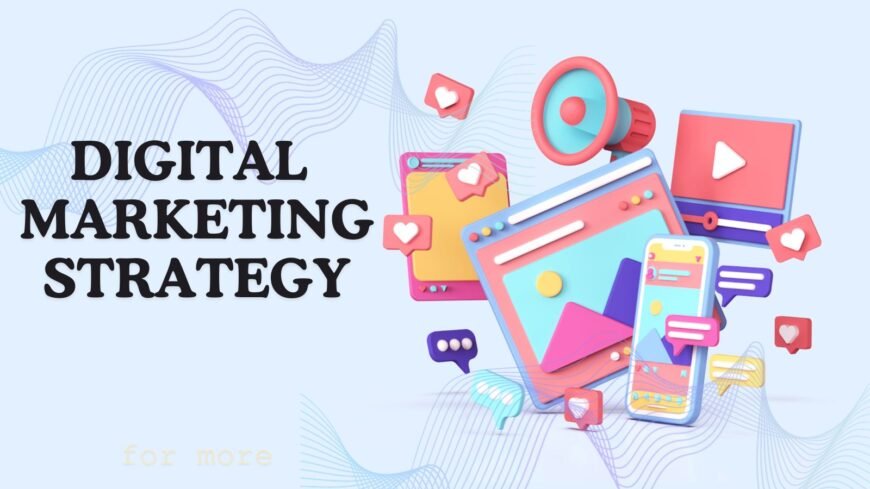
Your business needs a digital marketing strategy to reach today’s connected customers, but how do you get started? Creating a comprehensive digital marketing plan may seem overwhelming, but following a proven framework can help you develop an effective strategy to achieve your key business goals. In five steps, you’ll have a data-driven roadmap to engage your target audience, drive more traffic, generate leads, and boost sales through digital channels.
Whether you have a team of marketers or a small business owner handling it yourself, a digital marketing strategy is essential. Follow these steps to gain valuable customer insights, choose the proper marketing channels, set key performance indicators, and optimize your efforts to maximize your return on investment. With the right strategy driving your digital marketing efforts, you’ll be well on your way to connecting with customers and growing your business.
Marketing Strategy vs. Marketing Tactics
To get results, you need a well-defined digital marketing strategy. This strategic plan will guide your tactical efforts and ensure you achieve vital goals. Your strategy outlines the overall direction and vision for your digital marketing efforts. It should answer questions like:
- Who is your target audience?
- What are your key marketing objectives?
- How will you achieve those goals?
Tactics are the specific actions you take to implement your strategy. Things like:
- Running social media ads
- Optimizing your website for search engines
- Creating email marketing campaigns
- Building partnerships with influencers
While tactics may change frequently based on new opportunities or technologies, your underlying strategy should remain consistent. Review and revise your digital marketing strategy every 6-12 months to ensure you progress toward your key goals.
How To Create A Digital Marketing Strategy?
You need an effective digital marketing strategy to succeed in today’s digital landscape. The five main types are:
Content Marketing
Creating and promoting valuable content to attract and engage your audience. Post blogs and start a podcast or YouTube channel. Publish helpful social media posts, emails, and resources for your customers.
Search Engine Optimization
Optimizing your website and content to rank higher in search engines like Google. Focus on keywords, page titles, URL structures, internal linking, and more. Higher rankings mean more organic traffic.
Social Media Marketing
Build brand awareness and connect with your customers on social platforms. Create profiles, post regularly, engage with followers, and run social media ads to reach new potential customers.
Pay-Per-Click Advertising
Bid on keywords to display your ads to people searching for related terms. Options like Google Ads and Facebook Ads allow you to target your audience and drive traffic to your site. You only pay when people click your ads.
Email Marketing
Collect email addresses and send regular newsletters, promotions, and other marketing emails to engage your subscribers. Email is a direct line of communication to your customers. Build trust and loyalty with a well-designed email marketing campaign.
Steps to Create a Digital Marketing Strategy
The steps to creating a digital marketing strategy are as follows: Define your goals. Research your target audience. Analyze your competition.
Define Your Business Goals
You must establish concrete objectives to create an effective digital marketing strategy. Ask yourself: What do I want to achieve? Do you want to increase brand awareness, drive traffic to your website, generate more leads, or boost sales?
Once you determine your primary goals, establish specific and measurable key performance indicators (KPIs) to track your progress. For example, if your goal is to increase website traffic, your KPI could be achieving 5,000 new monthly visitors. To generate more leads, aim to capture 50 new leads each week.
You can optimize your digital marketing efforts and allocate resources efficiently with clear goals and KPIs. You’ll know exactly what’s working and needs improvement to accomplish your objectives. Defining your business goals and KPIs is the first step to developing an effective digital marketing strategy.
Research Your Target Audience
You need to know your audience to create an effective digital marketing strategy.
Conduct buyer persona research to identify your target customers. Map out details like:
- Demographics: Age, location, income, education
- Behaviors: Where do they spend time online? What content do they consume?
- Motivations: What are their needs, desires, and pain points? Why would they buy from you?
Analyzing this data will allow you to tailor your messaging and marketing to what your audience cares about. You’ll be able to reach the right people in the right places at the correct times.
With well-defined buyer personas guiding your efforts, you’ll be equipped to build a digital marketing strategy that truly resonates. Your content, ads, email campaigns, and more will speak directly to your customers’ needs, increasing traffic, leads, and sales.
Take the time to dive deep into your target audience. The insights you gain will fuel your success, allowing you to market to and build relationships with your ideal customers.
Choose Your Digital Marketing Channels
Promote your content on the channels where your audience spends the most time. Some of the major options include:
- Social media: Share updates, blog posts, and promotions on platforms like Facebook, Instagram, and LinkedIn. Engage with your followers by posting and commenting regularly.
- Email marketing: Send a regular newsletter with blog updates, resources, and promotions. Build your list by offering a content upgrade like an eBook or checklist in exchange for subscribers’ emails.
- SEO: Optimize your website content for search engines like Google so people can find you organically. Use keywords, internal linking, and fast load times to improve your rankings in search results.
- Pay-per-click (PPC) ads: Run targeted ads on search engines, social media, and display ad networks. Choose keywords and audiences that match your content and offers. Measure results to optimize your ad spend.
- Webinars: Host live or pre-recorded video presentations to engage your audience and promote your offers. Record webinars so people can view them on-demand.
- Podcasting: Start your podcast to share advice, interview industry experts, and promote your products and services. Syndicate your show on significant platforms like iTunes, Spotify, and Stitchery.
Distributing on a mix of channels will allow you to reach more people in your target audience. Focus on the options that best match how your customers consume information. An integrated digital marketing strategy will give you greater visibility and drive more traffic and leads.
Pinpoint your KPIs
You must determine key performance indicators (KPIs) to create an effective digital marketing strategy. Decide what metrics matter most to your business goals. Do you want to increase traffic, conversions, revenue, or brand awareness? Choose 2-3 quantifiable KPIs to focus on, such as:
- Traffic (page views, unique visitors)
- Engagement (time on site, pages/session)
- Conversions (form fills, purchases)
- Revenue (sales, average order value)
- Brand (social media followers, mentions)
Set concrete targets for your KPIs and track them regularly to measure the success of your digital marketing efforts. Adjust your strategy as needed to hit your key performance indicators.
Frequently Asked Questions about Digital Marketing Strategy
Are you looking to kickstart your digital marketing strategy but have some questions? Here are a few common FAQs to help you get started
- What is digital marketing strategy?
A digital marketing strategy outlines a comprehensive plan to leverage online platforms and tools effectively to achieve marketing objectives, such as increasing brand awareness, driving website traffic, or boosting sales.
2) Why is a digital marketing strategy necessary?
A well-defined digital marketing strategy helps businesses reach their target audience more effectively, maximize their online presence, and achieve specific marketing goals in a structured and measurable manner.
3) What platforms should I focus on?
Focus on the platforms where your target audience spends the most time. For most businesses today, that includes:
- Social media (Facebook, Instagram, LinkedIn)
- Search engines (Google, Bing)
- Your website
Start with 1-2 platforms and build from there based on your resources and customer needs.
Conclusion
You have the blueprint to build a digital marketing strategy to help your business achieve its goals. With the tips and tools we’ve discussed, you’ll be able to reach your target audience, boost brand awareness, increase conversions, and ultimately drive more revenue. But remember, the key to success is consistency and optimization.
Monitor your campaigns’ performance, adjust as needed, and keep innovating to stay ahead of trends. If you commit to continually improving your digital marketing strategy over time, the sky is the limit for how far it can take your business. You’ve got this! Now, go out there, connect with your customers, spread your message, and achieve outstanding results. The future is digital.

